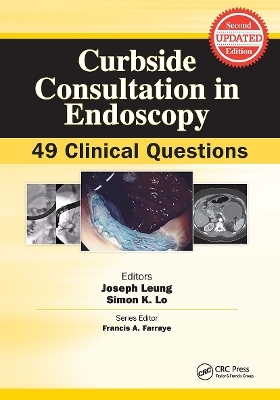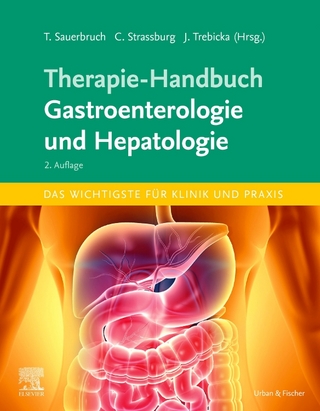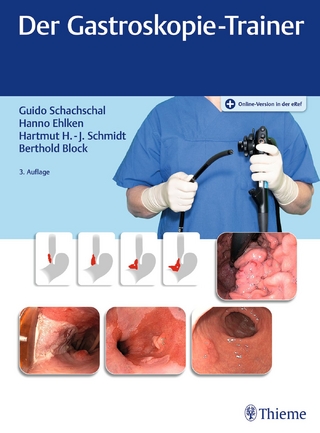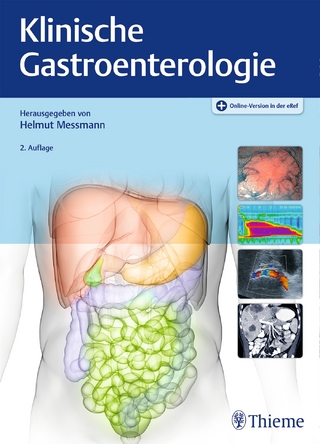
Curbside Consultation in Endoscopy
SLACK Incorporated (Verlag)
978-1-61711-047-4 (ISBN)
The Second Edition contains new questions and is completely updated!
Curbside Consultation in Endoscopy: 49 Clinical Questions, Second Edition contains new questions and brief, practical, and evidence-based answers to the most frequently asked questions that are posed during a “curbside consultation” between surgical colleagues.
Dr. Joseph Leung and Dr. Simon Lo have designed this unique reference, which offers expert advice, preferences, and opinions on tough clinical questions and situations commonly encountered in endoscopy.
The unique Q&A format provides quick access to current information related to therapeutic endoscopy with the simplicity of a conversation between two colleagues. Illustrative images, diagrams, and references are included to enhance the understanding of endoscopy.
Some of the questions that are answered:
• What Do People Do for the Treatment of Achalasia These Days? Does it Matter if the Symptoms Are Severe or if the Patient Is Elderly?
• I Had a Difficult Colonoscopy and No Matter What I Tried, I Just Could Not Reach the Cecum. I Maxed Out on IV Sedations and Have No Anesthesiology Support. Can You Help Me?
• A 45-Year-Old Patient With Known Hepatitis C Was Admitted Because of Massive Upper GI Bleeding. What Should I Do?
• A 55-Year-Old Veteran Had a Ruptured Gallbladder and a Difficult Cholecystectomy. Postoperatively, the Patient Had Persistent Bile Leakage Despite Months of Multiple Biliary Stenting. What Can I Do?
• How Do We Manage a Patient With a 10-cm Pseudocyst Who Is Currently Asymptomatic
• What Is a Reliable Method to Estimate the Location of a Lesion Found on Capsule Endoscopy?
Curbside Consultation in Endoscopy: 49 Clinical Questions, Second Edition provides information basic enough for residents while also incorporating expert advice that even high-volume clinicians will appreciate. Gastroenterologists, fellows and residents in training, surgical attendings, and surgical residents will all benefit from the user-friendly and casual format and the expert advice contained within.
>Joseph Leung, MD, FRCP, FACP, FASGE, MACG is currently the Mr. & Mrs. C.W. Law Professor of Medicine at the University of California, Davis School of Medicine and the Chief of Gastroenterology for the VA Northern California Health Care System. Dr. Leung is a Fellow of the Royal College of Physicians of Edinburgh, Glasgow and London, as well as the Hong Kong College of Physicians and Hong Kong Academy of Medicine. He is also a Fellow of the American College of Physicians, American College of Gastroenterology, and the American Society for Gastrointestinal Endoscopy. >Dr. Leung has pioneered a number of therapeutic endoscopy procedures including epinephrine injection for ulcer hemostasis, urgent nasobiliary drainage for acute suppurative cholangitis, the design and development of the Cotton-Leung stent for biliary drainage and palliation of malignant obstructive jaundice, and the water exchange colonoscopy for colorectal cancer screening. >Dr. Leung has spent the last 25 years improving ERCP training for GI trainees. He has organized many teaching endoscopy workshops locally, nationally, and internationally and participated as teaching faculty in many more. His current research interest includes the use of a mechanical simulator for ERCP training and methods to improve proximal adenoma detection on colonoscopy. He has published RCTs on the impact of coached EMS practice on clinical ERCP performance of trainees. >Dr. Leung received the ACG Senior Governor Award in 2004 and ASGE Master Endoscopist Award in 2005 and Master of American College of Gastroenterology in 2010. He was a former Associate Editor for Gastrointestinal Endoscopy and currently Executive Editor-in-Chief for the Journal of Interventional Gastroenterology. He is the author or coauthor of more than 400 peer-reviewed articles, abstracts, and book chapters, as well as 5 books. > >Simon K. Lo, MD is the Director of Endoscopy at Cedars-Sinai Medical Center, where he is also the director of the Pancreatic Diseases Program and head of the Interventional Endoscopy Training. He is a Clinical Professor of Medicine at David Geffen School of Medicine at UCLA. He obtained his MD degree from New York University. He completed a gastroenterology fellowship at the Integrated GI Training Program at UCLA. In 1989, he refined his biliary endoscopy skill under renowned Professor Kees Huibregtse at the Academic Medical Center in Amsterdam. He has served on the ASGE and numerous other international society committees and was elected Governor of the American College of Gastroenterology for multiple terms. >Known for his extensive endoscopy experience and clinical interests, Dr. Lo has evaluated many new technologies to treat GERD, obesity, and mucosal lesions. He pioneered in several small bowel procedures including different platforms of capsule endoscopy and device-assisted enteroscopy. In spite of his diverse skills, he is most noted for his work in endoscopy for pancreatic and biliary diseases. For 21 years, he has organized and co-hosted a highly regarded symposium on pancreatic and biliary endoscopy that features the most recognized biliary endoscopists in the world. He is currently devoting most of his time to building a program to integrate basic science and clinical services for improvement in the understanding and treatment of pancreatitis and pancreatic cancer. >Central to the advancement of health care is the willingness to learn and the commitment to teach. Dr. Lo has learned from some of the most noted figures in endoscopy and GI sciences, while engaging in many educational events in endoscopy here and abroad. He has spoken extensively in many countries and has trained numerous gastroenterologists and GI interventionists over the years. He has also published many articles in the field. He is exceedingly grateful to have the opportunity to work with Dr. Joseph Leung on this very practical and valuable book on endoscopy.
Dedication Acknowledgments About the Editors Contributing Authors Foreword by Stephen M. Schutz, MD Preface Introduction SECTION I UPPER ENDOSCOPY Question 1 An 81-Year-Old Healthy Male Is Found to Have A 12-cm Long Segment Barrett’s Esophagus And Several Tiny Raised Lesions, With Moderate to High Grade Dysplasia in One Location. What Do I Tell The Patient? What Therapy Is Appropriate? Paulo Sakai, MD, PhD, FASGE and Fauze Maluf-Filho, MD, PhD, FASGE Question 2 A 46-Year-Old Female With Cirrhosis Came in With Severe Upper GI Bleeding. Her Proximal Stomach Is Filled With Large Clots and Gastric Varices Are Suspected. How Can I Tell for Certain Endoscopically, and What Is the Treatment? Anne Thai, MD and Joseph Leung, MD, FRCP, FACP, FASGE, MACG Question 3 What Are the Essential Tools for Removing Esophagogastric Foreign Bodies, and When Should I Apply These Devices? Luo-wei Wang, MD, PhD and Zhao-shen Li, MD Question 4 You Were Called by the ER Physician Regarding a Female Who Attempted to Commit Suicide by Drinking Toilet Cleaning Solution. There Were Obvious Burns Around the Mouth and Tongue. What Would You Do Next? Rajesh Gupta, MD, DM and D. Nageshwar Reddy, MD, DM, FRCP, DSc Question 5 What Is the Current Recommendation for Endoscopic Surveillance of Barrett’s Esophagus, and How Can We Improve the Results With the Current Technologies? Paulo Sakai, MD, PhD, FASGE and Fauze Maluf-Filho, MD, PhD, FASGE Question 6 What Should I Do if I Have Inadvertently Perforated the Viscus During an Endoscopy? Gregory Haber, MD Question 7 What Is the Current Expert Opinion on What Hemostasis Technique to Use in Treating a Visible Vessel or Dieulafoy Lesion? When Should I Involve a Surgeon? Brintha K. Enestvedt, MD, MBA and Michael L. Kochman, MD, FACP Question 8 What Do People Do for the Treatment of Achalasia These Days? Does it Matter if the Symptoms Are Severe or if the Patient Is Elderly? Drew Ingram, MD and Joseph Leung, MD, FRCP, FACP, FASGE, MACG Question 9 A 65-Year-Old Male With a Long-Standing GERD Complained of Recent Onset of Progressive Difficulty Swallowing (Especially Solids) and Subjective Weight Loss. How Should I Evaluate the Patient? Emmanuel C. Gorospe, MD, MPH, FACP and Kenneth K. Wang, MD, FACG, AGAF, FASGE Question 10 Several Trips to the ER for a 56-Year-Old Mechanic for SOB and Iron Deficient Anemia Revealed Positive FOBT, but EGD and Colonoscopies Did not Identify the Bleeding Source. He Takes NSAIDs Regularly for Arthritis Pain. Is There a Role for Enteroscopy? Neel K. Mann, MD, MPH Question 11 A 59-Year-Old Professor Had Dyspepsia and Subjective Weight Loss. He Was Treated Previously for H pylori Infection. EGD and Biopsies Showed Chronic Inflammation With Intestinal Metaplasia and One Focal Area of Low-Grade Dysplasia. What Do I Do?. Chun-Ying Wu, MD, PhD, MPH, LL.M., LL.B. and Francis K.L. Chan, MD, FACG Question 12 A 38-Year-Old Mildly Obese Female Presented With GERD Symptoms and Was Found to Have a Persistently Elevated Amylase Level Around 250 Iu/L (Normal < 125) but Normal Lipase. How Should I Manage This Patient? Sooraj Tejaswi, MD, MSPH Question 13 A 35-Year-Old Female Presented With Epigastric Pain, Difficulty Swallowing, and Subjective Fever 1 Month After Gastric Bypass Surgery. She Was Seen in the ER Because of Recent Hematemesis. What Do I Do?. Andrew Yen, MD, FACG and Joseph Leung, MD, FRCP, FACP, FASGE, MACG Question 14 A 45-Year-Old Alcoholic Was Admitted With Abdominal Pain, Coffee Ground Emesis, and Mild Anemia. Upper Endoscopy Shows a Few Polypoid Masses in the Gastric Body and Pigmentations in the Antrum. What Should I Do? Sooraj Tejaswi, MD, MSPH Question 15 A 45-Year-Old Patient With Known Hepatitis C Was Admitted Because of Massive Upper GI Bleeding. What Should I Do? Cara Torruellas, MD, MPH and Joseph Leung, MD, FRCP, FACP, FASGE, MACG Question 16 Bougienage, Balloon Dilation, Cautery Cutting, Stenting, and Steroid Injection Have All Been Described to Treat Benign Strictures of the GI Tract. Is There a Right Way of Doing This? Jeffrey L. Conklin, MD, FACP SECTION II COLONOSCOPY Question 17 Which of My Patients With Ulcerative Colitis Need /u201cSurveillance/u201d Colonoscopy? How Should the Procedure Be Performed? Michael F. Picco, MD, PhD and Francis A. Farraye, MD, MSc Question 18 I Had a Difficult Colonoscopy and No Matter What I Tried, I Just Could not Reach the Cecum. I Maxed out on IV Sedations and Have no Anesthesiology Support. Can You Help Me? Felix W. Leung, MD, FACG Question 19 A 68-Year-Old Male With Significant Comorbidities Presented With Weight Loss and New Onset Vomiting. Investigation Showed Colonic Obstruction With Poorly Differentiated Adenocarcinoma Involving the Sigmoid Colon. Do I Consider Stenting? Todd H. Baron, MD, FASGE Question 20 A 58-Year-Old Female Underwent a Screening Colonoscopy That Showed a 2.5-cm Flat Polyp in the Proximal Ascending Colon. I Tattooed the Area and Biopsied the Polyp, Which Was Initially Reported as Hyperplastic. What Should I Do? Michael Bourke, MBBS, FRACP and Farzan Fahrtash Bahin, MBBS (Hons) Question 21 What Is the Role of Chromoendoscopy in Screening Colonoscopy? Will it Help to Differentiate Different Types of Polyps, and Is it Useful for Proximal Serrated Polyps? Ihab I. El Hajj, MD, MPH and Charles J. Kahi, MD, MSc Question 22 I Have Trouble Doing a Complete Colonoscopy in Some of My Patients Because of Poor Bowel Preparation. What Should I Do to Insure a Properly Prepared Colon? Han-Mo Chiu, MD, PhD SECTION III ENDOSCOPIC RETROGRADE CHOLANGIOPANCREATOGRAPHY Question 23 A 55-Year-Old Veteran Had a Ruptured Gallbladder and a Difficult Cholecystectomy. Postoperatively, the Patient Had Persistent Bile Leakage Despite Months of Multiple Biliary Stenting. What Can I Do? Joseph Leung, MD, FRCP, FACP, FASGE, MACG and Catherine Ngo, MD Question 24 A 65-Year-Old Male on Plavix Following a Recent MI and Coronary Stenting Was Seen in the ER With Fever, Pain, Jaundice, and a WBC of 18,000. US Showed a Dilated Bile Duct of 15 mm and a Gallbladder Full of Stones. MRCP Revealed a 15-mm Stone in the Distal CBD. What Would You Do? Wei-Chih Liao, MD, PhD Question 25 What Is the Best Endoscopic Method to Diagnose Pancreatic Cancer? What Is the Best Way to Sample Tissue to Diagnose Suspected Bile Duct Cancer? John G. Lee, MD Question 26 A 68-Year-Old Man With a Klatskin’s Tumor Was Referred for Consideration of ERCP and Palliative Drainage. How Should I Manage the Patient? Joseph Leung, MD, FRCP, FACP, FASGE, MACG Question 27 An Elderly Patient With Multiple Medical Problems Presents With Acute Pancreatitis and Stones in the Gallbladder. LFTs Show AST of 90 and ALT of 95, Both Declining. MRCP Shows no CBD Stones or Ductal Dilation. Is ERCP Indicated? Stuart Sherman, MD Question 28 I Have a Patient With Biliary-Type Pain, but no Other Evidence of Bile Duct Disease (Normal Diameter Duct on Ultrasound, Normal Liver Function Tests). How Should Such a Patient Be Managed? Martin L. Freeman, MD, FACG, FASGE Question 29 How Can We Accurately Determine the Appropriate Length of the Stent to Use in a Patient With a Bile Duct Stricture? Joseph Leung, MD, FRCP, FACP, FASGE, MACG and Erina Foster, MD Question 30 A 56-Year-Old Female Presents With Recurrent RUQ Pain, Impaired LFTs, Elevated ALKP, and Transaminases. She Had a Prior ERCP and Possible Biliary Papillotomy for Similar Complaints but She Does not Recall the Diagnosis. What Should I Do? Joseph Leung, MD, FRCP, FACP, FASGE, MACG
| Reihe/Serie | Curbside Consultation in Gastroenterology |
|---|---|
| Sprache | englisch |
| Maße | 178 x 254 mm |
| Gewicht | 657 g |
| Themenwelt | Medizinische Fachgebiete ► Innere Medizin ► Gastroenterologie |
| ISBN-10 | 1-61711-047-7 / 1617110477 |
| ISBN-13 | 978-1-61711-047-4 / 9781617110474 |
| Zustand | Neuware |
| Haben Sie eine Frage zum Produkt? |
aus dem Bereich


